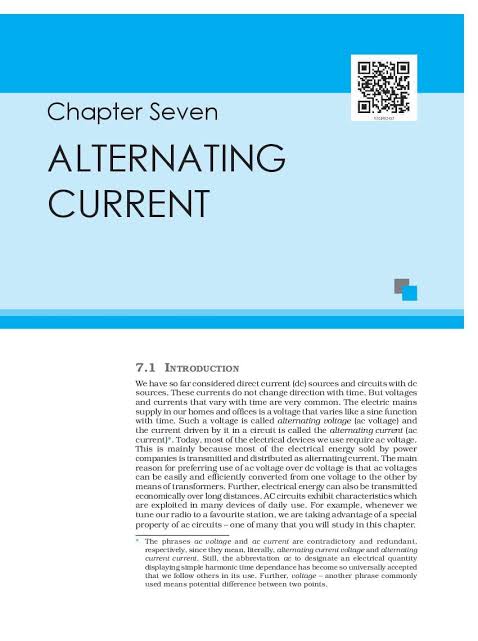
Download Chapter 7 Book 📚
Question & answer ❓
1. What is meant by alternating current (AC)?
Answer: Alternating current (AC) is an electric current that reverses its direction periodically, unlike direct current (DC), which flows in one direction. The voltage in AC circuits also alternates in polarity periodically.
2. What is the difference between AC and DC?
Answer: AC changes its direction periodically, while DC flows in one constant direction. AC is used in households and industries, whereas DC is often used in batteries and electronic devices.
3. What is the significance of the phase difference in AC circuits?
Answer: The phase difference indicates the difference in phase between the voltage and current in an AC circuit. It determines whether the circuit is inductive or capacitive and affects the power factor.
4. What is the power factor in an AC circuit?
Answer: The power factor is the cosine of the phase angle between the voltage and current in an AC circuit. It represents the efficiency with which the circuit converts electrical power into useful work.
5. Explain the concept of impedance in an AC circuit.
Answer: Impedance is the total opposition that a circuit offers to the flow of alternating current. It is a combination of resistance and reactance (both inductive and capacitive).
6. What is meant by resonance in an AC circuit?
Answer: Resonance occurs in an AC circuit when the inductive reactance and capacitive reactance are equal in magnitude but opposite in phase, causing the impedance to be minimum and the current to be maximum.
7. How does a transformer work in an AC circuit?
Answer: A transformer works on the principle of electromagnetic induction. It transfers electrical energy between two circuits through inductively coupled conductors—the primary and secondary coils—by varying the AC voltage.
8. What is the role of inductance in an AC circuit?
Answer: Inductance opposes changes in current in an AC circuit. It causes a phase difference between voltage and current, leading to a lagging current in inductive circuits.
9. What happens to the current in a purely capacitive AC circuit?
Answer: In a purely capacitive AC circuit, the current leads the voltage by 90 degrees. The current reaches its maximum value before the voltage does.
10. Why is the RMS value used in AC circuits?
Answer: The RMS (Root Mean Square) value of AC is used because it represents the equivalent DC value that would produce the same power in a resistor. It provides a measure of the effective value of the alternating current or voltage.
11. What is the significance of the frequency of an AC supply?
Answer: The frequency of an AC supply determines how many times the current reverses its direction per second. It is a critical factor in the design and operation of AC circuits and devices.
12. How does a capacitor behave in an AC circuit?
Answer: In an AC circuit, a capacitor allows the current to flow, but it causes a phase difference where the current leads the voltage. The capacitive reactance decreases with an increase in frequency.
13. What is the average value of an AC over a complete cycle?
Answer: The average value of a pure sinusoidal AC over a complete cycle is zero because the positive half-cycle cancels out the negative half-cycle.
14. Why does an AC circuit with only resistance have no phase difference between voltage and current?
Answer: In a purely resistive AC circuit, the voltage and current are in phase because the resistor does not store energy; it only dissipates energy as heat.
15. What is meant by the term ‘reactance’ in an AC circuit?
Answer: Reactance is the opposition to the flow of AC due to inductance or capacitance. It is frequency-dependent and contributes to the total impedance of the circuit.
16. Explain the principle of electromagnetic induction in AC circuits.
Answer: Electromagnetic induction is the process by which a changing magnetic field induces an electromotive force (EMF) or voltage in a conductor. This principle is the basis for AC generators and transformers.
17. What is meant by ‘lagging’ and ‘leading’ in the context of AC circuits?
Answer: ‘Lagging’ means the current is behind the voltage in phase, typically in inductive circuits. ‘Leading’ means the current is ahead of the voltage, usually in capacitive circuits.
18. How does the concept of resonance apply to tuning radios?
Answer: Tuning a radio involves adjusting the circuit to resonate at the same frequency as the radio station signal, which maximizes the signal strength and allows for clear reception.
19. What role does the inductor play in a choke coil in fluorescent lamps?
Answer: The inductor in a choke coil limits the current in fluorescent lamps by creating an opposing voltage due to its inductive reactance, thereby controlling the current and preventing damage to the lamp.
20. Why is AC preferred over DC for long-distance power transmission?
Answer: AC is preferred over DC for long-distance power transmission because it can be easily transformed to higher or lower voltages using transformers, minimizing energy loss due to resistance in the wires.

Get involved!
Comments